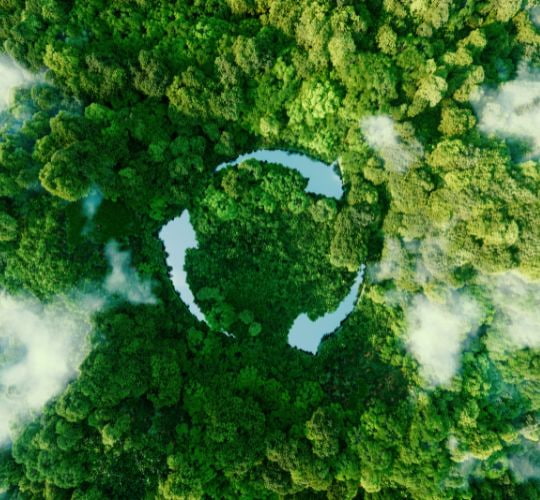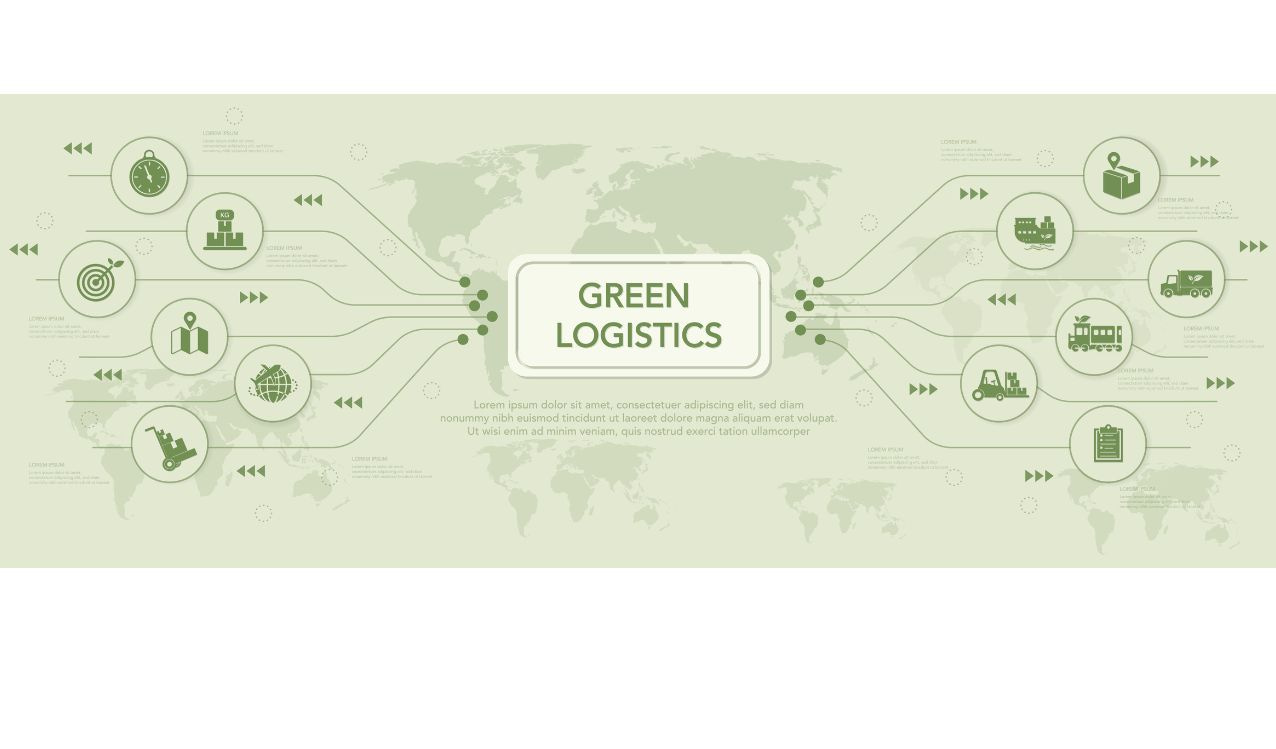Discover the keys to sustainable logistics
What is green logistics?
With a society increasingly aware of climate change, the commitment to sustainable practices is reaching all economic sectors. This is especially necessary in the case of logistics, as it is one of the most polluting activities. Did you know that 12% of greenhouse gases generated in the world come from transport?
Logistics is green when its operations are developed in a sustainable way to reduce environmental pollution and rationalize the consumption of natural resources. Suppliers who commit to it are essential when it comes to counteracting the negative impact historically associated with the sector.
Far from being a mere declaration of intentions, sustainable logistics crystallizes in concrete and effective measures. It is therefore worth analyzing aspects such as its characteristics, its implementation and measurement methods, its benefits and its future.
Every business is unique, like our solutions
Contact usWhat are the main objectives and characteristics of green logistics?
The raison d’être of green logistics is the achievement of a series of specific objectives that have already proven their usefulness in reconciling operational efficiency and sustainability.
Measuring the CO2 footprint
To be truly sustainable, logistics needs to determine how much energy its activities consume and how much polluting gases they generate. Only when a logistics operator translates its environmental impact into data can it begin to develop strategies capable of fixing the problem.
Reduce pollution
Once we have measured our environmental footprint, it is time to get down to work. The objective here is to eliminate or minimise the pollution generated at each stage of the logistics process. Its ultimate goal is to contribute to alleviating the real damage that the planet is already experiencing (greenhouse effect, water acidification, deforestation, climate change, etc.).
Logistics operators tackle their fight against environmental damage through multiple methodologies (reducing carbon emissions, improving energy efficiency, generating less waste, etc.). After all, the environmental damage to be combated can be hydrological, terrestrial, atmospheric or auditory, so it is advisable to combat it from several fronts.

Save resources
Environmental logistics is based on an incontestable reality: the production of supplies is polluting, so they must be used to the maximum. Consequently, recycling and the eco-responsible disposal of waste must be prioritized. A good example of this can be found in the reuse of packaging.
Extending green logistics to the entire supply chain
When we talk about the pollution caused by traditional logistics, we usually think exclusively about the transport of goods. However, trucks, ships and planes are not the only ones responsible for environmental damage. Each stage of the supply chain can and must be optimized from a sustainability perspective.
Maintaining control over the sustainability of the entire supply chain (storage, packaging, returns, etc.) is a real challenge. Hence the convenience of having a green logistics provider that fully manages the entire process.
Logisfashion's green action plan
Sustainability is no longer just something linked to the environment or ecological movements, but has expanded its impact to society and companies as a whole as driving forces for change.
The integration of sustainability as a strategic axis has become a priority for our company. The need to constantly innovate in our management models is essential to gain competitiveness, transparency and efficiency.
At Logisfashion we assume the need to measure and minimize the effects that our activity has on the environment. The efficiency of our facilities is a first step to guarantee our clients the reduction of emissions and waste.
We are aware that, to guarantee sustainable management, we must certify ourselves in compliance with the sustainable development goals and objectives (SDG) and that it is not just a question of doing things well, but of developing a strategy based on the SDGs to accelerate change.
We are working on it, from 3 lines of action:
- Environmental: Processes and services that are more respectful of our environment.
- Identification and management of risks.
- Socio-Labor: Business culture, life in the company and equality plans. Working for people and caring for talent and others.
- Corporate Social Responsibility: Committed to sustainable policies. We actively collaborate with associations in our environment in order to support the positive development of the local community.

Benefits of practicing sustainable logistics
When you opt for sustainable logistics, everyone wins. What’s more, achieving your goals is a win-win situation, as evidenced by the benefits listed below.
Benefits of sustainable logistics for the company
- It saves costs. Whether directly or indirectly, environmental logistics generates long-term profitability. Measures such as optimising warehouse space, recycling packaging or using less fuel bring significant economic savings.
- More agility. Various environmental logistics practices enable greater operational speed, which increases customer satisfaction. For example, by reducing the transport route, our shipments will arrive sooner.
- It improves corporate reputation. Environmental awareness is deeply rooted in society. A company that opts for environmental logistics demonstrates its commitment to the planet, generating a positive perception among investors, customers and suppliers. Not for nothing, there are environmental badges (such as ISO 14001) to certify the adoption of such practices.
- It enables regulatory compliance. The progressive rigour of environmental regulation translates into strong economic sanctions for non-compliant companies. Having a sustainable logistics operator gives us the peace of mind of knowing that we are complying with these requirements.
- It boosts competitive advantage. This is actually a consequence of all the above benefits. Obviously, a company that saves money, acts quickly, respects the law and has a good reputation is bound to outperform its competitors.
- It boosts sales. Consumers want to take care of the planet through their purchasing decisions. That is why they prefer to buy products from companies that demonstrate their environmental responsibility.
Benefits of environmental logistics for the planet
- It reduces environmental pollution. The main benefit of green logistics is to reduce the footprint left on the planet by logistics operations. In this way, we manage to offset the damage that has been caused to the planet.
- It contributes to slowing down climate change. This adverse phenomenon is a consequence of global warming, which in turn is a consequence of the emission of greenhouse gases. Eco-sustainable logistics plays a decisive role in stopping a cycle that threatens to destroy the planet.
- It saves natural resources. Through recycling and reuse, sustainable logistics makes the most of valuable environmental resources such as water or wood. For the same reason, it contributes to generating less waste.
- It preserves ecosystems. This is an effect derived from the previous points. As we already know, pollution, climate change and the irresponsible exploitation of natural resources seriously endanger environmental biodiversity.
- It improves the quality of life. Not only flora and fauna benefit when we respect the environment.
- Sustainable logistics also benefits human well-being. There is no doubt that we all need a planet in good condition to enjoy physical and mental well-being.
How to carry out sustainable logistics
As we have already mentioned, sustainable logistics covers the entire supply chain. Consequently, environmental methodologies have a place in all logistics operations.
Storage
Environmental logistics begins in the warehouse. Indeed, both the facilities and the activities carried out there can be optimized from a sustainability perspective.
During this first stage, there are many practices aimed at reducing pollution:
- Build sustainable warehouses. This is what is known as logistics infrastructure 4.0: buildings whose design and management is governed by ecological sustainability.
- Energy efficiency: Our logistics centres have LEED Silver and LEED Gold certification and BREAAM, which certifies the sustainable construction of all our buildings.
- Proximity of the warehouse to the end customer.
- Optimise storage space.
- Automate stock management and facilities to speed up picking & packing (reduces resource consumption).
- Use natural ventilation systems.
- Do not use more air conditioning than necessary.
- Use renewable energy.
- Take advantage of natural light.
- Take into account the expiry date and storage conditions of perishable products to prevent them from expiring before delivery.
- Digitise delivery notes and other documents to reduce paper consumption.
Packaging
Sustainable packaging is a perfect example of green logistics. After all, both its manufacture and the raw materials used in it have a severe environmental impact. Thus, it is preferable to use boxes made of wood or recycled cardboard instead of single-use plastic or expanded polystyrene, which are characterized by being highly polluting.
At this point, eco-sustainable logistics can save resources with the following practices:
- Rational use of packaging (do not use more packaging than necessary).
- Prioritise reusable packaging over single-use packaging.
- Use packaging made from biodegradable materials so that its decomposition does not generate waste.
It is worth bearing in mind that the sustainability of packaging is certified by environmental certifications (FSC, PEFC, Ok Compost, etc.). Others (such as Zero Waste and OCS certification) validate actions aimed at reducing waste.
Transport and distribution
30% of greenhouse gases generated in Europe come from the transport of goods. It is therefore easy to imagine the importance of bringing sustainability to this stage of the supply chain.
There are several measures capable of making green transport a reality. Among the most implemented, we can highlight the following:
- Optimizing routes to save fuel (reducing journeys, avoiding unnecessary trips, reducing waiting times, etc.).
- Reducing empty kilometers.
- Making the most of the transport’s load capacity.
- Using environmentally friendly means of transport (e.g. electric vehicles).
- Carrying out appropriate maintenance of the vehicle fleet to prevent deterioration from making it more polluting.
- Replacing fossil fuels with alternatives with a lower ecological impact (such as biodiesel or green hydrogen).
- Monitoring the distribution route via software to enable the sustainable last mile.
Returns
Respect for the environment does not end with the delivery of the goods to the final customer. Incorrectly managing the return of products would double the pollution caused by the logistics process. That is why it is so necessary to extend eco-sustainable measures to this last stage.
Reverse logistics can also be made green through several specific measures:
- Refurbish, recycle or resell returned goods instead of throwing them away.
- Use automated sorting systems to quickly decide the destination of returned items.
- Establish local return points to avoid the use of transport.
Analyse returns data to identify their cause. This practice will help reduce returns in the future, thus promoting sustainable logistics.
How can the sustainability of a logistics operator be measured?
One of the characteristics of green logistics is that it has specific metrics (KPIs). This, together with obtaining environmental badges, allows us to know when we are dealing with a truly sustainable logistics partner.
Key KPIs for environmental logistics
- Load capacity utilization. Measures the degree of utilization of the means of transport. The higher the KPI, the fewer trips will have to be made, which favors the achievement of the sustainable last mile.
- Recycling rate. Indicates what percentage of the materials used by the logistics partner are recycled in relation to the total. The operator’s sustainability will be directly proportional to this KPI.
- Energy consumption. Evaluates the energy expenditure of warehouses and vehicles. It can be reduced by implementing clean technologies and eco-sustainable means of transport. The lower this KPI, the greener the logistics.
- Greenhouse gas (GHG) emissions. Monitoring it allows detecting how much room for improvement the logistics operator’s environmental strategy has. The transport of goods, energy consumption, waste generation, employee travel, and the purchase of goods or services generate GHG.
- Water use. Various logistics activities (such as cleaning or refrigeration) demand this natural resource. Quantifying its consumption is key to saving it.
- Empty mileage. This transport metric reveals the kilometres travelled without a load. The operational inefficiency of such journeys increases their environmental footprint.
Data from official sources
As well as metrics, data provided by official sources allow us to standardize our way of measuring the sustainability of a logistics operator. Some of the relevant organizations in this regard are:
- Ministry for Ecological Transition and the Demographic Challenge (MITECO) of the Government of Spain.
- European Environment Agency (EEA).
- United Nations Environment Programme (UNEP).
Sustainable Development Goals
Within the 2030 Agenda there are several Sustainable Development Goals (SDG) that are directly related to ecology. Such is the case of SDG 7 (affordable clean energy) and SDG 13 (climate action). Sustainable logistics operators, such as ourselves, distinguish ourselves by taking these goals into account and working towards their achievement.
Environmental badges
Environmental labels are the main indicator that a logistics partner is truly sustainable. After all, these are official certifications awarded by specialized external organizations.
Among the main environmental certifications, the following are worth mentioning:
- LEED (Leadership in Energy and Environmental Design). This is a certification system developed by the U.S. Green Building Council (USGBC) and is internationally recognised. It evaluates the environmental performance and sustainability of buildings using a points system.
- ISO 14001. This international standard sets out the requirements that determine the effectiveness of an Environmental Management System (EMS). With it, large companies obtain a reference framework that allows them to identify and manage environmental risks.
- EMAS (Eco-Management and Audit Scheme). This is a voluntary environmental audit system developed by the European Union. It is characterised by being more demanding than ISO 14001, as it requires the publication of an environmental declaration validated by an external verifier.

Future of green logistics
Green logistics is the future. In other words, logistics operations will soon be green or they will not be at all. Growing concerns about climate change are leading governments to adopt ever stricter regulations in this regard.
Logistics partners that rise to the occasion
Meeting the rigorous demands of sustainable logistics is not within everyone’s reach. Consider, for example, challenges such as having to adapt to environmental regulations in various countries or combining various means of transport to minimise environmental impact.
As international and multimodal logistics operators, Logisfashion has sufficient resources to offer truly green solutions to our clients.
Logisfashion bets on electric vehicles
Emerging technologies have a lot to offer to green logistics. The innovation they bring with them contributes to optimizing the environmental efficiency of the supply chain. Let’s look at some examples of this:
- Route optimization using AI.
- Streamlining energy consumption (e.g. refrigeration of perishable products) thanks to the Internet of Things (IoT).
- Utilization of storage space with autonomous mobile robots (AMRs).
At Logisfashion, environmental awareness is part of our DNA. Not in vain, we have LEED Silver and Gold certifications that certify the extent to which we manage the supply chain sustainably. Strengthen your company’s alliance with the planet by choosing us as your green logistics provider.
